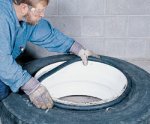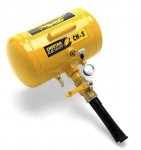GoHot229
Member
- 908
- 16
- 18
- Location
- Cason Old Field NC. 704-851-9953
It has been brought up often times, the difficulty of inflating 20" tires on Custom Wheels used as of late for the 'BEEFED' offroad bogger look ie. those 14.00's and 16.00's and what have you. First, be absolutely SURE that you understand the method you will use, no guesswork please. We have pictured below a 'DOUGHNUT' used for 19.5" tubeless truck tires, although by past experience I have employed it on 20" tires satisfactorily. As is self explanatory, you can see how to employ this 'RING' as it is simple in design HOWEVER with the pinching force, squeezing it outward, it can turn it into a missile shooting away from the wheel. STAY OUT OF THE POSSABLE PATH it VERY seldom comes off that way,BUT.... Usually it simply slowly squeezes out as the bead rises and seats, pinched completely out and ends resting on the tire and wheel Another item is the BEAD TANK. It is used to force a HIGH VOLUME of air, instantaniously The entire tank in less than a second, between the tire and rim, essentially blowing the bead outwards, it is aimed closely to the tire/rim and blasted at an angle following the inside surface of the RIM. It is relatively simple and is not dangerous, unlike ether, but will push backward against you as the air escapes out the snout forwards. However may take a couple or possibly several tries, but once mastered, typically just one try will usually succeed.This method using ether is only recommended for those experienced with it. Personally, I would stay away if your a novice, if you want to keep your facial and arm hair. The problem with ether for a novice is knowing how much to spray, how to light, and what to do if there's a mistake. An exploding can of ether....I'd hate to think of the aftermath. This stuff is simple and that's also what makes it so dangerous. It may appear simple but get Cavalier or Complacent with it and the next thing you know something goes wrong, and especially with 'SPLIT RING' wheels, you could be severely hurt or maimed with them, but that's for another discussion completely. Be safe........ and a NOTE: these tools also apply to smaller tire/wheels with the use of the 14-15 and 16" bead rings and inflatable pinch ring used on the tread surface. Of course the valve core should be removed to allow the rapid high volume of air to "shock" the beads 'apart' as it were, rapidly seating the bead and a remote clip-on chuck should always be used.There's a knack to it, but it's easily learned.
Attachments
-
15 KB Views: 28
-
38.1 KB Views: 25
-
4.6 KB Views: 75
-
13 KB Views: 16
Last edited by a moderator:






